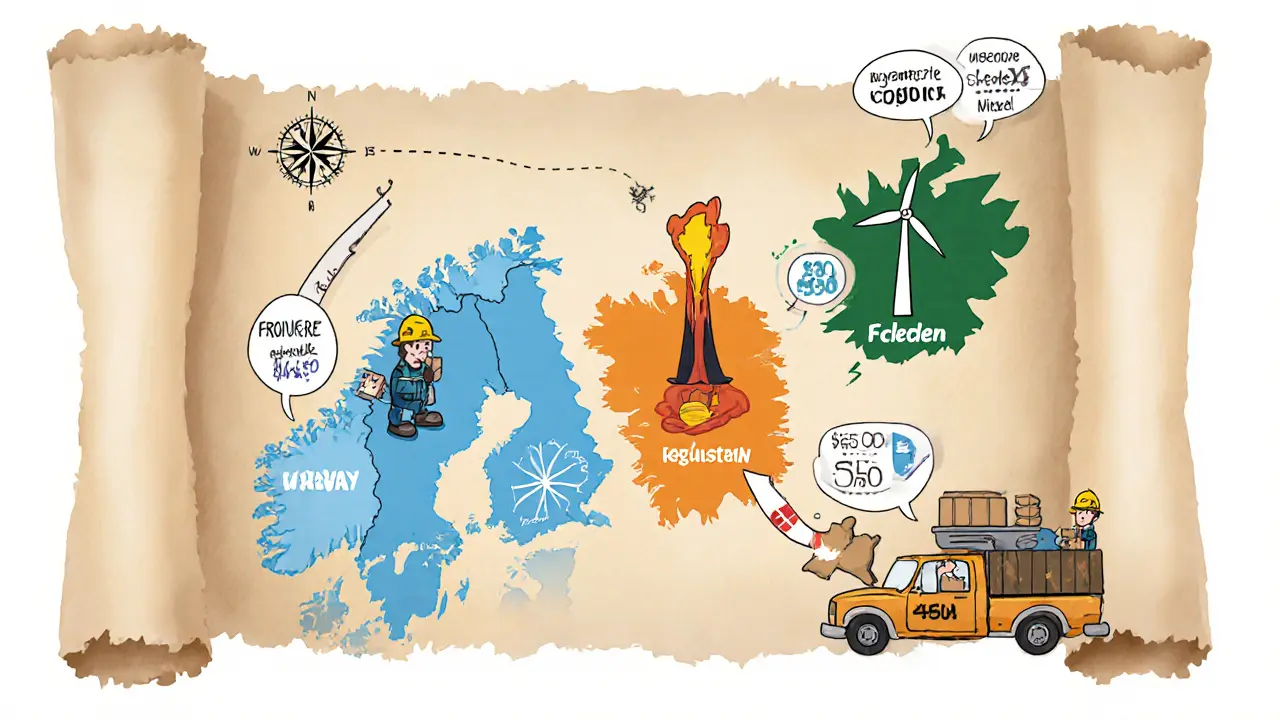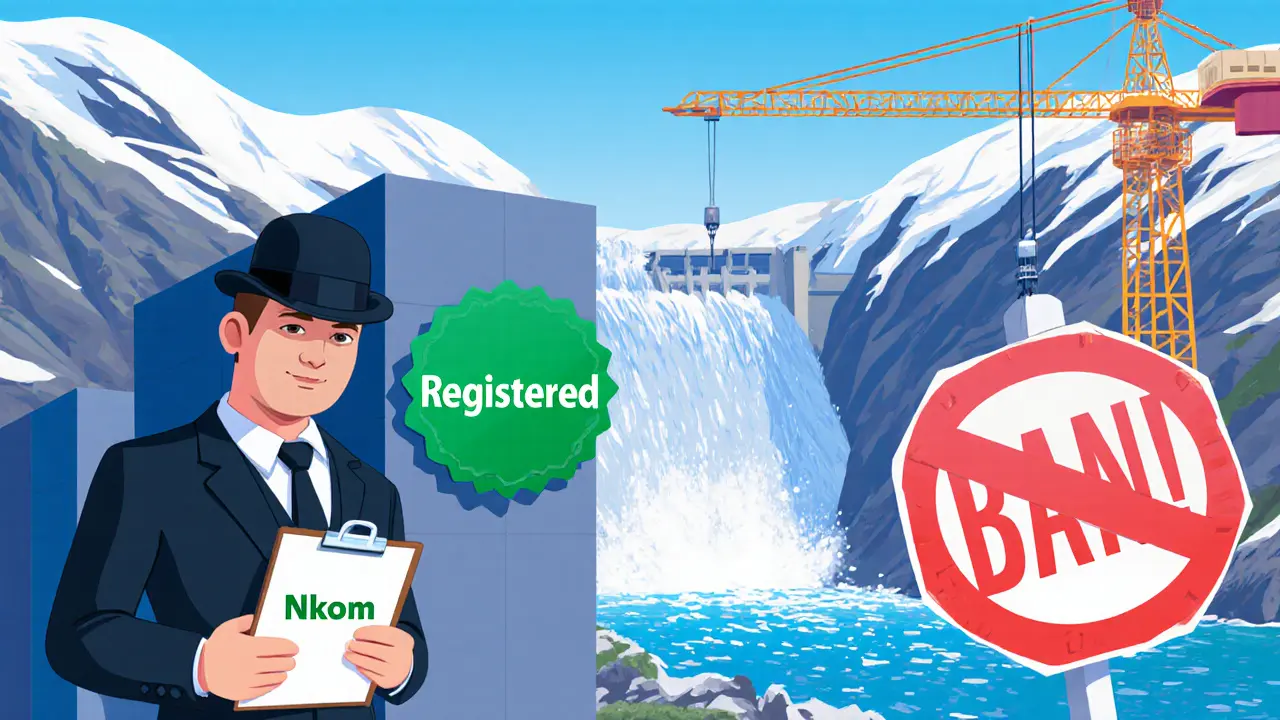Norway Crypto Mining Compliance Checker
Compliance Assessment Result
Compare Norway with Nordic alternatives for crypto mining:
| Country | Avg Power Cost (USD/MWh) | Regulatory Tone | Renewable Share | Ban Status |
|---|---|---|---|---|
| Norway | ≈ 45 | Restrictive - registration + new-facility ban | ≈ 98% hydro | Temporary ban on new mining data centres |
| Iceland | ≈ 30 | Supportive - low-tax, clear permitting | ≈ 100% geothermal & hydro | No specific ban |
| Sweden | ≈ 50 | Neutral - case-by-case approval | ≈ 54% hydro, 45% wind | No ban, but environmental reviews apply |
| Finland | ≈ 55 | Neutral - permits required, no mining-specific rules | ≈ 80% hydro & wind | No ban |
Norwegian cryptocurrency mining data center regulation is a national framework introduced to control crypto‑mining activities that consume large amounts of electricity. Launched on 1January2025, it combines a mandatory data‑center registry with a temporary ban on new power‑intensive mining facilities. The move makes Norway the most restrictive European jurisdiction for crypto mining, even though the country enjoys abundant hydro‑electric power.
Quick Takeaways
- All crypto‑mining data centres must register with the Norwegian Communications Authority (Nkom) before construction.
- New mining facilities are prohibited from being built starting autumn2025; existing sites can operate until further notice.
- Non‑compliance can trigger fines up to 5% of annual turnover.
- Compliance costs include legal documentation, ongoing reporting, and potential redesign of power usage.
- Operators are looking at Iceland, Sweden and North America as alternative locations.
Regulatory Framework Overview
The new rules sit on two pillars. The first is the Norwegian Communications Authority (Nkom), which administers the data‑center registration system under the Electronic Communications Act. The second pillar is a joint effort by the Ministry of Digitalization and Public Administration and the Ministry of Energy. Minister Karianne Tung (Digitalization) and Minister Terje Aasland (Energy) jointly announced the temporary ban.
The framework aligns with upcoming EU Markets in Crypto‑Assets (MiCA) regulations, ensuring that Norway’s rules will not clash with broader European standards once MiCA is fully implemented in 2025.
Registration Requirements & Process
Operators must submit a detailed dossier to Nkom covering:
- Company name and legal status.
- Physical address of the data centre.
- Designated representative for government communications.
- Comprehensive service description, explicitly stating whether crypto‑mining is offered.
- Customer list, differentiating public agencies from private businesses.
The registration fee is modest (roughly NOK5000), but the real cost lies in preparing legal documents and setting up a reporting pipeline that can produce quarterly energy‑consumption figures. Failure to register by 1July2025 - the deadline for existing centres - results in a warning, followed by fines up to 5% of the company’s turnover.
Temporary Ban Details
Starting in autumn2025, Norway will prohibit the construction of any new data centre whose primary purpose is cryptocurrency mining and that exceeds an undefined “energy‑intensity” threshold. While the exact kWh per hash metric is still being debated, the ban clearly targets the most power‑hungry ASIC rigs.
Existing facilities can continue operating, but they are barred from expanding capacity or adding new mining rigs without explicit ministerial approval. This nuanced approach differs from China’s 2021 total crackdown, which forced all miners offline.

Compliance Costs & Penalties
Beyond registration fees, operators face ongoing compliance expenses:
- Legal counsel to interpret both national and upcoming EU rules - estimated NOK200000 per year for mid‑size firms.
- Technical upgrades to monitor real‑time power draw, often requiring additional sensors and SCADA integration.
- Administrative staff to compile quarterly reports for Nkom.
If a company is found operating an unregistered or non‑compliant mining rig, the penalty can reach 5% of annual turnover - a severe deterrent for larger players.
Impact on Operators & Market Dynamics
Industry analysts note a split reaction. Energy policy experts applaud the move as a responsible allocation of renewable electricity, especially given Norway’s goal to keep hydro‑power for high‑value industries.
Crypto‑mining advocates argue the rules are technologically discriminatory and create legal uncertainty. Small‑scale miners, who lack the resources for extensive reporting, are the most vulnerable and many have already shut down or are seeking relocation.
Internationally, the ban is prompting a shift in investment. Recent surveys show a 30% drop in planned Norwegian mining capacity for 2025‑2026, with firms redirecting capital to Iceland (low‑cost geothermal power) and Sweden’s north‑shore hydro zones, where regulatory climates remain friendlier.
Alternatives & Relocation Strategies
Operators evaluating a move should consider three key criteria:
- Energy price stability - look for contracts with fixed rates to avoid price spikes.
- Regulatory certainty - jurisdictions with clear, published guidelines (e.g., Iceland’s mining‑friendly policy).
- Infrastructure availability - proximity to high‑capacity renewable grids reduces transmission losses.
Below is a quick comparison of the most attractive Nordic alternatives.
| Country | Average Power Cost (USD/MWh) | Regulatory Tone | Renewable Share | Ban Status |
|---|---|---|---|---|
| Norway | ≈45 | Restrictive - registration + new‑facility ban | ≈98% hydro | Temporary ban on new mining data centres |
| Iceland | ≈30 | Supportive - low‑tax, clear permitting | ≈100% geothermal & hydro | No specific ban |
| Sweden | ≈50 | Neutral - case‑by‑case approval | ≈54% hydro, 45% wind | No ban, but environmental reviews apply |
| Finland | ≈55 | Neutral - permits required, no mining‑specific rules | ≈80% hydro & wind | No ban |
Future Outlook
While the current ban is labeled “temporary,” the government has hinted at a possible extension if crypto‑mining fails to align with Norway’s climate targets. Ongoing consultations with the Norwegian Financial Supervisory Authority (FSA) suggest that future EU‑aligned crypto‑asset rules could add another compliance layer.
For operators that stay, the focus will shift to improving energy efficiency-adopting newer ASIC models that consume less power per hash-and diversifying services (e.g., offering data‑hosting for public agencies) to meet the registration’s transparency demands.
Observers worldwide are watching Norway as a potential template. If the balance between renewable resource protection and digital‑economy growth proves successful, other nations with abundant clean power may adopt similar hybrid models.
Frequently Asked Questions
Do I need to register my crypto mining operation if I only use a few ASICs?
Yes. The registration rule applies to any data‑center that offers mining services, regardless of size. Small operators often face higher per‑unit compliance costs, which is why many choose to relocate.
What happens if I built a mining rig before the autumn 2025 ban but finish construction afterward?
As long as the facility was fully registered before the July12025 deadline and you obtain a construction permit beforehand, you can finish building. However, any expansion beyond the originally approved capacity will need separate ministerial approval.
Can I appeal a fine for non‑compliance?
Yes. Fines can be contested before the Norwegian courts within 30days of notification. Successful appeals usually hinge on proving that the operator submitted all required documentation on time.
Is the energy‑intensity threshold for the ban publicly defined?
Not yet. Official documents only state that the ban targets “most power‑intensive” operations. Industry groups are lobbying for a clear kWh‑per‑hash metric to avoid legal ambiguity.
How do Norway’s restrictions compare to EU MiCA requirements?
MiCA focuses on the issuance and trading of crypto‑assets, while Norway’s rules target the physical energy consumption of mining. Both regimes will coexist, meaning operators must satisfy energy‑related registration and financial‑service compliance simultaneously.
Norway crypto mining restrictions are reshaping where and how the global mining industry operates. Understanding the registration process, potential penalties, and alternative jurisdictions is essential for anyone planning to keep mining in the Nordics beyond 2025.


Rohit Sreenath
Norway is just protecting its own people. Electricity isn't a free-for-all. If you want to burn power for digital gambling, go somewhere else. This isn't oppression-it's responsibility.